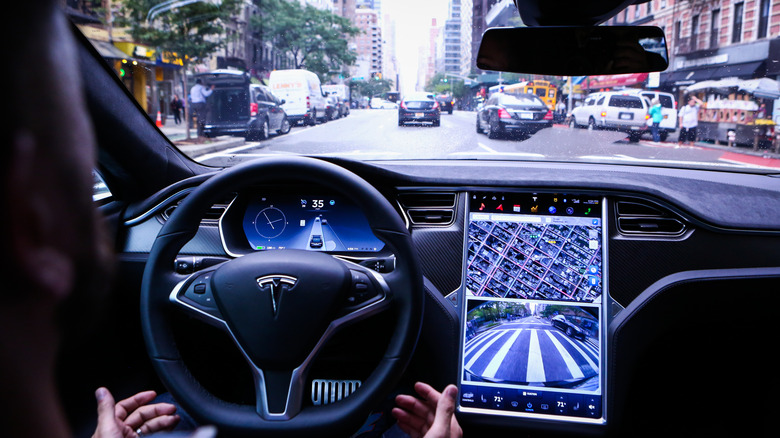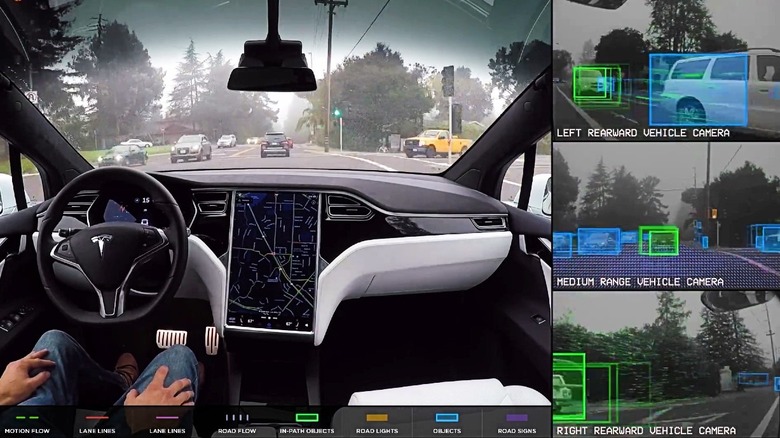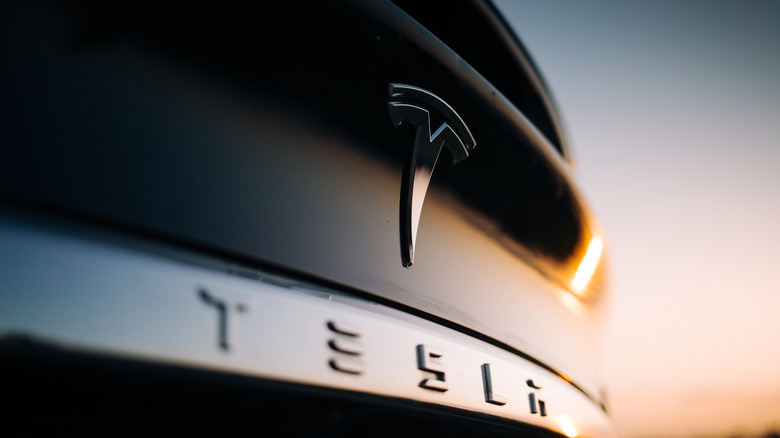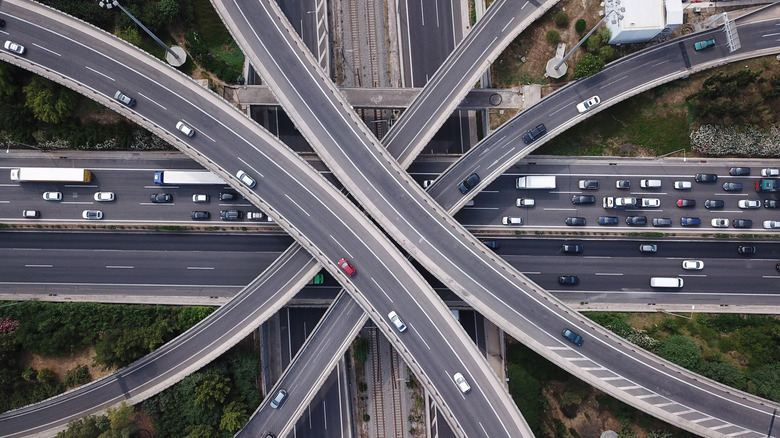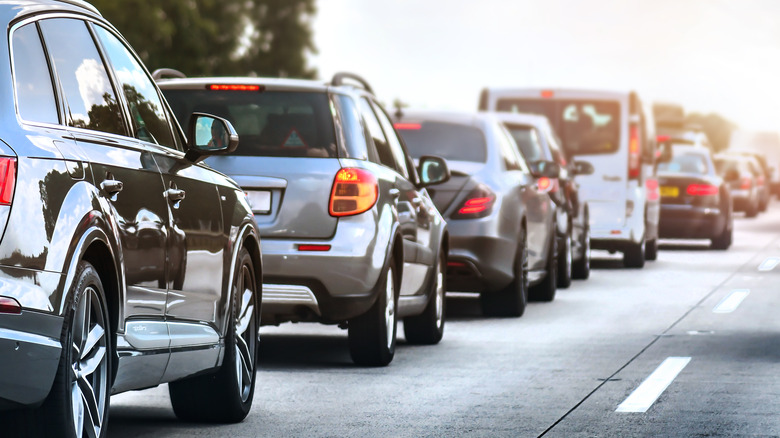What Is Tesla Autopilot?
As if making the switch from fossil fuels to all-electric wasn't enough, EVs brought even more to the table: self-driving car technologies. Tesla, the leading EV maker in the world with more than 930,000 vehicles delivered in 2021 (via Best Selling Cars), is also the leader in autonomous car tech. The NHTSA explains that self-driving is a utopic vision of the future, one in which cars will be able to drive without human intervention or supervision.
The road safety agency created six levels of autonomous driving ranging from 0 to 5. As of 2022, most new vehicles come with Level 1 and Level 2 features, which include parking assist, emergency braking, lane change assistance, and others. Tesla is among the few automakers testing out Level 3 autonomous driving tech — in this case, with its Full Self Driving (FSD) beta software. Tesla cars using FSD drive under supervision from the driver who needs to be ready to intervene at all times.
In the years since autonomous driving technology was first introduced, automakers have been competing to provide users with the smartest cars. Smart features in EVs have become one of the main differentiators between brands for potential buyers. While self-driving still faces resistance, the public is slowly embracing the technology as features like parking assistance becomes more common, helping alleviate safety concerns.
What is Tesla Autopilot?
Tesla says that its Autopilot is the "future of driving." All new Tesla cars come with advanced hardware and software that allow the vehicle to offer autonomous features. The software is regularly updated with over-the-air updates, making it easy for drivers to run the latest version of Autopilot in their cars, including any changes the company has made to its system.
The automaker explains that Autopilot is designed to relieve drivers from the "burdensome parts of driving." Among other things, a Tesla vehicle can navigate with Autopilot. The car will suggest lane changes, optimize routes, and make adjustments when necessary. When drivers engage in "Navigate," the car will steer itself toward highway interchanges and exits, matching the destination set by a driver.
Another Autopilot feature is "Autosteer." It's recommended that drivers use this mode when driving on tighter and more complex roads. A Tesla can also be summoned using Smart Summon with which the parked car will find its way to the driver. Drivers must opt into the FSD experience using a Tesla account, and it needs to be purchased separately. All Tesla EVs also come with "basic" features, which include emergency braking, collision warning, auto high beams, and more.
How does Tesla Autopilot work?
Autopilot works thanks to what the automaker calls Tesla Vision, which is a system of unique hardware and software developed by the company. Tesla uses eight cameras that provide input data for a vision processing system driven by AI. The cameras provide 360 degrees of visual information with up to 820 feet of range for its forward-looking perspective. The brain of a Tesla will map out the streets and create its own "environmental awareness."
Tesla worked for years to perfect the intelligence of its software through training and AI. The maker's cars are equipped with a Hardware 3 onboard computer that has the high processing speeds required to analyze data in real time and take action. As Autopilot Review explains, Tesla used to have cameras and lidar sensors, but by mid-2021 it updated to a system called Pure Vision Autopilot. Pure Vision only uses high-definition cameras to reduce noise data input so the AI that interprets the "world-model" constructed by the cameras can make decisions more rapidly and efficiently.
Autopilot comes with any Tesla built after September 2014, and even those who have a Tesla without Autopilot can opt to purchase two packages, assuming the right hardware is available: Autopilot and Full Self-Driving. Tesla adds that drivers can test drive the features at their local Tesla store. The price of Full-Self Driving has increased over the past years. Elon Musk announced via Twitter that on January 17, 2022, FSD would rise from $10,000 to $12,000.
Tesla Autopilot benefits
The Coalition for the Future of Mobility says that autonomous driving increases accessibility for people with disabilities and seniors. Smarter driving also means less traffic and positive environmental impacts. Mosaic 51, a hardware and services company working with tech leaders like Facebook and Google, explains that autonomous driving technologies have many benefits.
More than 90% of all vehicular accidents in the U.S. are attributed by the government to human error. Autonomous driving features have the potential to reduce those human errors and bring fatality and accident numbers down. A 2017 report by the Insurance Institute for Highway Safety (IIHS) revealed that Autopilot in the Tesla Model S resulted in an 11% drop in liability coverage claims related to property, as well as a 21% decrease in liability coverage claims related to bodily injury.
The report linked the safety improvements to the front crash prevention and blind-spot monitoring systems. Self-driving platforms like Tesla's FSD have also been described as having "superhuman" perception because they generate a much more complex view of the environment, can access traffic, weather, and GPS data, and combine all the information in real time.
Tesla Autopilot negatives
Self-driving software in its most advanced stages (so far) still isn't ready to take over the wheel completely. Drivers who mistake autonomous driving Level 1 with Level 3 systems, which are still a work in progress, put themselves and others on the road at risk. As reported by IIHS on August 7, 2018, a deadly crash involving a Tesla Model X revealed what drivers shouldn't do. Tesla's Autopilot was found to have given the driver two visual alerts and one audio alert to place his hands on the wheel over a period of 18 minutes before the crash. Six seconds before the fatal impact, the driver's hands weren't detected on the wheel, according to the report.
Tesla's Q4 2021 Vehicle Safety Report reveals the company registered one crash in Autopilot for every 4.31 million miles driven, and one crash for every 1.59 million miles driven in a Tesla without Autopilot. This is a significant number, as the NHTSA reports only 484,000 miles for every crash related to the average American car. However, in 2021 the NHTSA opened an investigation into Tesla's Autopilot. As reported by The Guardian, more than 765,000 vehicles were covered by the investigation, including the Model Y, X, S, and 3. In late 2021, the NHTSA said it was looking into 11 crashes that included deaths and injuries in which Teslas were on Autopilot.
